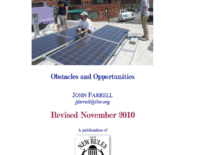When author Michael Pollan spoke at Cal Poly San Luis Obispo in mid-October, it’s a safe bet his hosts didn’t offer fresh cherries to the “local foods” advocate. As a locavore — someone who tries to eat only food grown within a 100-mile radius of them — Pollan would have likely reacted to cherries like a vampire reacts to garlic. At this time of year, any fresh cherries in northern California would most likely have come from orchards in Chile, roughly 6,000 miles to the southeast.
Yet, when Pollan was handed the microphone he probably did not turn to David Wehner, Dean of the college hosting the event, and ask, “By the way, Dean – Where did the electricity powering this thing come from?”
Maybe he should have.
At least some of that electricity had just completed a 1,000 mile journey. The energy was converted from wind to electricity at the Klondike generating facility just south of the Washington-Oregon border. The electricity traveled over power lines down the entire state of Oregon, then traversing three-quarters of the length of California to arrive at the microphone in Pollan’s hand at Cal Poly. So, does it matter that this electricity began life 1,000 miles from the microphone it powered?
That question is at the heart of the report, “Energy Self-Reliant States,” published in October by the New Rules Project. The report shows why “local energy” matters and then looks at the renewable energy potential of each state.



